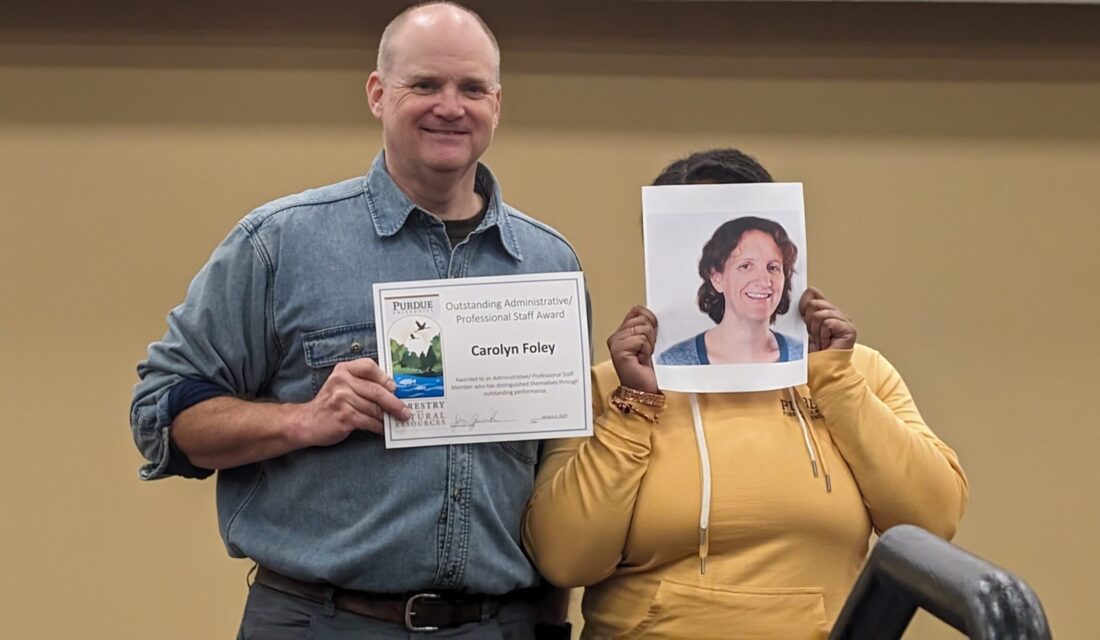
Carolyn Foley, research coordinator for Illinois-Indiana Sea Grant (IISG), received the Purdue University Forestry and Natural Resources (FNR) 2023 Outstanding Administrative/Professional Staff Member Award. Foley was recognized for her leadership, resourcefulness and selfless contributions to FNR and IISG, as well as for her diversity, equity, inclusion and belonging efforts for both organizations.
 Foley has served the Illinois-Indiana Sea Grant research program since 2010 and is the primary contact for questions related to requests for proposals and IISG funded research projects at all stages of completion. She also helps plan and execute research and outreach activities on campus and with several collaborative partners across the Great Lakes region. Foley started the IISG Scholars Program in 2021, which provides funding and professional development for graduate students as well as faculty from institutes of higher learning in Illinois and Indiana. In the past year, she managed a complex research program of her own, studying aquatic invertebrates and small-bodies fishes, and supported Cooperative Science and Monitoring Initiative efforts on Lake Michigan while also serving as research coordinator for IISG as a whole. Professionally, Foley served as the Past-Chair of the National Sea Grant Research Coordinators Network and Chair of the Great Lakes Research Coordinators Network in 2023. In the summer of 2023, Foley began serving as the Co-Chair of the Purdue FNR Diversity, Equity, Inclusion, Justice and Belonging (DEIJB) Committee.
Foley has served the Illinois-Indiana Sea Grant research program since 2010 and is the primary contact for questions related to requests for proposals and IISG funded research projects at all stages of completion. She also helps plan and execute research and outreach activities on campus and with several collaborative partners across the Great Lakes region. Foley started the IISG Scholars Program in 2021, which provides funding and professional development for graduate students as well as faculty from institutes of higher learning in Illinois and Indiana. In the past year, she managed a complex research program of her own, studying aquatic invertebrates and small-bodies fishes, and supported Cooperative Science and Monitoring Initiative efforts on Lake Michigan while also serving as research coordinator for IISG as a whole. Professionally, Foley served as the Past-Chair of the National Sea Grant Research Coordinators Network and Chair of the Great Lakes Research Coordinators Network in 2023. In the summer of 2023, Foley began serving as the Co-Chair of the Purdue FNR Diversity, Equity, Inclusion, Justice and Belonging (DEIJB) Committee.
Her nominators shared that “Carolyn’s dedication to the research and educational mission of Purdue and FNR is top tier” and that she “is valued for her leadership within the broader Sea Grant network and beyond.” One colleague summed it up like this: “Carolyn embodies the concept that if you care more about it than anyone else, you own it. Every day, she shows up and finds creative ways to keep the trains running and helps find solutions to thorny issues to make us, and everyone around her, better at doing what they do.”
Foley was previously honored at Purdue with the College of Agriculture’s Unsung Diversity Hero Award in 2021.
Illinois-Indiana Sea Grant is a partnership between NOAA, University of Illinois Extension, and Purdue University Forestry and Natural Resources, bringing science together with communities for solutions that work. Sea Grant is a network of 34 science, education and outreach programs located in every coastal and Great Lakes state, Lake Champlain, Puerto Rico and Guam.

